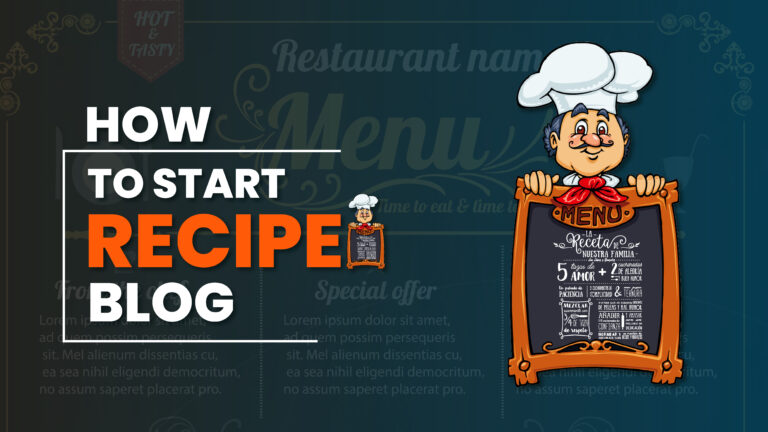Thinking about sharing your favorite dishes online?
Starting a recipe blog in 2026 is easier and more rewarding than ever. With food content dominating social media and readers craving authentic, homegrown recipes, there’s never been a better time to turn your passion for cooking into a blog that earns attention (and maybe even income!).
What is a Recipe Blog?
A recipe blog is an online space where food enthusiasts share their cooking creations, kitchen experiments, and step-by-step recipes with an audience.
It’s more than just posting what you cook it’s about telling the story behind each dish, helping others recreate it, and often building a community around shared food interests.
Recipe blogs can feature:
- Written recipes with photos or videos
- Nutrition tips and ingredient substitutes
- Personal stories, cultural food traditions, and cooking hacks
In 2026, many recipe blogs also integrate short-form videos, AI-generated meal planners, and interactive recipe cards making them more engaging and useful for readers.
Why Start a Recipe Blog in 2026?
Starting a recipe blog in 2026 is about more than just sharing food—it’s about expressing creativity, building an online presence, and opening doors to new opportunities.
Here are some key reasons why starting a recipe blog is worth it:
1. Share Your Passion:
A recipe blog allows you to inspire others with your favorite dishes, unique flavors, and personal cooking style. It’s a platform to express your love for food and connect with people who share similar tastes.
2. Build Your Personal Brand:
Establishing a recipe blog helps you create a recognizable identity within the food community. Over time, your voice, recipes, and visuals can set you apart and build trust with your audience.
3. Earn from Your Content:
A successful recipe blog can become a source of income through display ads, brand collaborations, affiliate marketing, and even self-published cookbooks or online classes.
4. Connect with a Global Audience:
Food has universal appeal. Your recipes can reach readers from around the world, helping you build a community that appreciates different cuisines and cultural influences.
5. Develop Valuable Skills:
Running a recipe blog teaches you essential digital skills content writing, food photography, SEO optimization, and social media marketing that can be applied to many creative careers.
How to Start a Recipe Blog (Step by Step)
Step 1: Choose a Niche for Your Recipe Blog
Choosing a niche is critical when starting a recipe blog. It helps your blog stand out from thousands of other cooking websites. A niche is essentially the specific type of recipes or food-related content you want to focus on. In 2025, niches that are gaining popularity include:
- Plant-based recipes: With the rise of veganism and plant-based diets, blogs focusing on this area are becoming highly sought after.
- Gluten-free baking: Many individuals are looking for gluten-free recipes due to dietary restrictions or personal preferences.
- Quick and easy meals: As people continue leading busy lives, recipes that focus on quick meal preparation are in demand.
- Healthy meals for weight loss: With an increasing focus on fitness and health, recipe blogs that offer healthy, low-calorie meals are trending.
- International cuisines: Explore lesser-known cuisines such as African, Caribbean, or Eastern European to introduce your readers to unique recipes.
Step 2: Select the Right Blogging Platform:
To start a recipe blog, you need a reliable platform to host your content. In 2026, some of the best platforms for blogging include:
- WordPress: Known for its flexibility, WordPress remains a top choice. With numerous plugins available, it’s easy to optimize for SEO and food blogging needs.
- Wix: This platform is ideal for those looking for an easy drag-and-drop website builder. Wix offers specific templates for food bloggers.
- Squarespace: It’s a popular choice for those seeking beautifully designed templates with minimal effort. It’s visually appealing for recipe blogs.
- Ghost: Known for its speed and SEO optimization, Ghost is a good option for recipe bloggers focused on content-driven sites.
Step 3: Purchase a Domain and Hosting
After choosing a platform, you’ll need a domain name and hosting. In 2026, it’s important to pick a domain name that is easy to remember and closely related to your niche. For example, if you’re focusing on gluten-free baking, you might choose a domain like “GlutenFreeBaker.com.”
For hosting, popular options include:
- Bluehost: Affordable and recommended for beginners.
- SiteGround: Known for speed and excellent customer service.
- Kinsta: A premium choice for high-traffic blogs looking for superior performance.
Step 4: Design an Engaging Blog
Design plays a crucial role in the success of your recipe blog. In 2026, clean, user-friendly designs are preferred by both users and search engines. Key design elements include:
- Mobile-responsive design: Ensure your blog looks great on all devices.
- Easy navigation: Your visitors should find it easy to explore recipes. Include a recipe index categorized by type, ingredient, or cuisine.
- Search functionality: Add a search bar that enables readers to find recipes quickly.
- Beautiful imagery: Use high-quality images of your recipes. The visual appeal of food is an essential part of recipe blogs.
Step 5: Create High-Quality Content
To stand out, you need to create content that resonates with your audience. Recipe blogs are highly visual, so along with well-written recipes, you need stunning food photography. Here’s how to do it:
- Write clear, concise recipes: Use step-by-step instructions with ingredient lists and cooking times. Break down complex processes into easy-to-follow steps.
- Add personal touches: Share personal stories or tips that relate to the recipes. However, ensure the focus remains on the food.
- Include nutritional information: With the health-conscious trend, people appreciate knowing the calorie count or macro breakdown of meals.
- Use professional food photography: Use natural lighting and close-up shots to make your dishes look appetizing. There are tools and apps that can help you edit photos to enhance their appeal.
Step 6: Optimize for SEO
Search engine optimization (SEO) is vital in driving traffic to your blog. In 2026, SEO trends emphasize both content relevance and technical optimizations. Here are some SEO practices to follow:
- Keyword research: Identify keywords relevant to your niche, like “vegan pasta recipes” or “gluten-free desserts,” and include them naturally in your content.
- Schema markup: Use recipe schema to improve the visibility of your posts on Google. It helps search engines understand the structure of your recipe.
- Page speed optimization: Compress your images and use tools like Google PageSpeed Insights to ensure your blog loads quickly.
- Internal linking: Link related posts and recipes to encourage visitors to stay longer on your site.
- Meta descriptions and title tags: Optimize your title tags and meta descriptions to increase the likelihood of clicks from search engine results.
Step 7: Promote Your Recipe Blog
Once your blog is set up and you’ve posted a few recipes, the next step is promotion. In 2025, the digital landscape offers many options to promote your blog and attract readers:
- Social media: Platforms like Instagram and Pinterest are perfect for sharing visually appealing recipe content. Use hashtags to reach a larger audience.
- Email newsletters: Create an email list to send new recipes, tips, and updates directly to your readers.
- Food blogging communities: Join platforms like FoodGawker and Yummly where food bloggers share their recipes and gain exposure.
- Collaborations with influencers: Reach out to influencers in the food niche for collaborations or guest posts. This helps build your credibility and audience.
Step 8: Monetize Your Recipe Blog
Once you’ve built a steady readership, it’s time to monetize your blog. In 2026, food blogs have several options for generating revenue:
- Affiliate marketing: Promote kitchen tools, ingredients, or books, and earn commissions for every sale made through your affiliate links. Programs like Amazon Associates or ShareASale offer great opportunities.
- Sponsored posts: As your blog grows, brands may approach you to create sponsored content. You can write posts featuring their products in your recipes.
- Ad networks: Sign up for ad networks like Google AdSense or Mediavine, which allow you to earn revenue through ads displayed on your site.
- Sell eBooks or courses: Once you’ve established authority in your niche, consider creating digital products like recipe eBooks or cooking courses.
Step 9: Engage with Your Audience
In 2026, building a loyal community around your blog is just as important as creating great content. Here’s how to engage your readers:
- Respond to comments: Encourage readers to leave comments and feedback on your recipes. Responding promptly builds rapport.
- Create polls and surveys: Ask your readers what they’d like to see more of on your blog.
- Host contests or giveaways: Offer cooking tools or ingredients as prizes to encourage reader interaction and increase traffic.
- Run live cooking sessions: Platforms like Instagram and YouTube allow you to host live cooking sessions, where you can interact with your audience in real time.
Conclusion
In 2026, starting a recipe blog is more than just sharing what’s on your plate—it’s about building a creative space that inspires, educates, and connects food lovers across the world. With the right niche, engaging storytelling, and smart promotion, your blog can grow into a go-to destination for delicious inspiration. Success comes from consistency and authenticity: offer real value, share recipes that excite your readers, and use SEO strategies to expand your reach. Whether you’re showcasing plant-based meals, gluten-free treats, or global cuisines, your recipe blog has the potential to stand out as a trusted and inspiring corner of the digital food world.
Frequently Asked Questions (FAQs)
How do I choose a niche for my recipe blog?
To choose a niche, consider your passions and audience demand. Look for areas where you have expertise and can provide unique value, such as plant-based recipes, gluten-free baking, or quick meals for busy professionals.
What are the best platforms to start a recipe blog?
The best platforms for starting a recipe blog in 2024 include WordPress, Wix, Squarespace, and Ghost. Each offers unique features such as customizable templates, easy-to-use interfaces, and SEO optimization tools.
How can I monetize my recipe blog?
You can monetize a recipe blog through affiliate marketing, sponsored posts, ad networks like Google AdSense, and selling digital products such as recipe eBooks or cooking courses.
How do I promote my recipe blog?
Promote your recipe blog through social media platforms like Instagram and Pinterest, join food blogging communities, build an email list, and collaborate with influencers for guest posts or product features.
What SEO strategies should I follow for a recipe blog?
Key SEO strategies include keyword research, using recipe schema for better search visibility, optimizing page speed, internal linking, and writing compelling meta descriptions and title tags to improve click-through rates.

